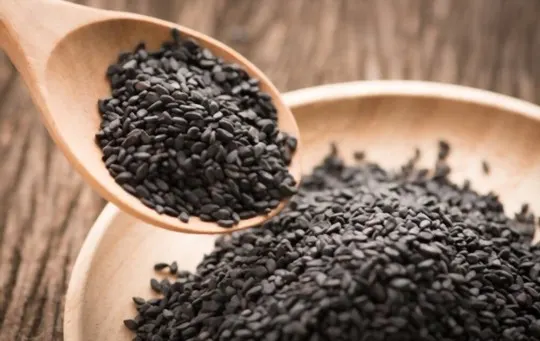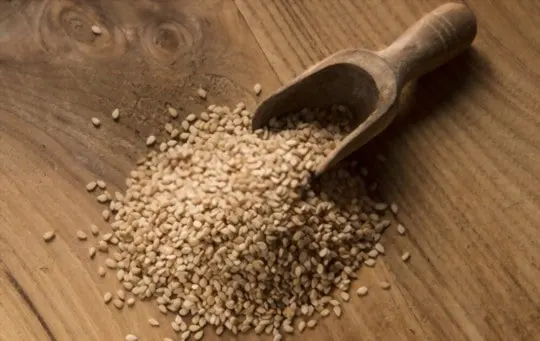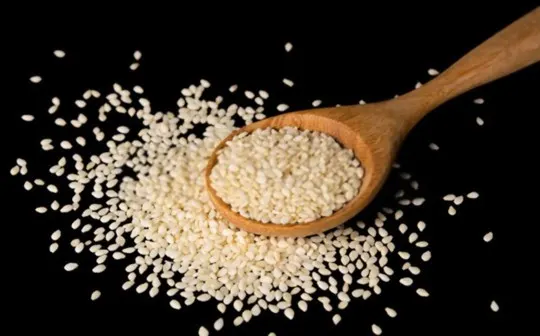Sesame Seeds have been used as a seasoning and a source of edible oil for more than 5,000 years.
In South Asian, Middle Eastern, Mediterranean, & Caribbean cooking, they are frequently used as a topping for hamburger buns, as a flavoring for a variety of Asian dishes, and as an ingredient in crackers and desserts.
The real question, though, is what do Sesame Seeds taste like? In this article, we will have a look at this popular condiment that has widely stretched its popularity all over the globe.
We’ll find out why exactly people love it, and how to incorporate it into your meals.
But first, do you know what they are? Let’s dive in and find out.
What are Sesame Seeds?

Sesame Seeds are found in the pods that are produced by the sesame plant, an annual herb.
When these pods reach maturity, they explode open audibly.
Each pod holds about 80 seeds once the hull is removed.
Sesame Seeds were provided to soldiers as rations during times of war to give them the energy they needed for their physically demanding tasks.
The sesame plant’s seeds are found inside the fruit, which is an elongated pod with grooves and tiny, oval-shaped seeds that are about 1/8 inch long.
The fruit cracks open as a result of drying, making it simple to remove the seeds.
A darker husk covers the actual seeds, which are typically removed before consumption.
Depending on the type of sesame plant, Sesame Seeds can be white, black, red, brown, or tan in color.
Black Sesame Seeds are typically used in Chinese cuisine, while white Sesame Seeds are the most popular variety in the United States.
What Do Sesame Seeds Taste Like?

Sesame seeds have a mild, sweet, and nutty flavor.
When eaten whole, they have a satisfying crunch.
To enhance their almond-like flavor and aroma and to make them more noticeable in dishes, toasting or baking is frequently used.
Compared to other varieties, black sesame seeds have a more substantial, richer flavor that is less sweet and more savory.
On the other hand, if your sesame seeds are overly bitter, that might mean that they are rancid.
Since sesame seed oil has no color and a mild nutty flavor, it is frequently used in stir-fries and Asian food.
Sesame seeds have a mildly variable flavor depending on their color, with black seeds tasting more earthy.
Sesame seeds are a healthy addition to meals because they are a good source of vitamin B1, dietary fiber, polyunsaturated fats, and other vitamins and minerals.
Sesamin, an anti-inflammatory and antioxidant compound found in sesame seeds, may help lessen joint pain and support mobility in people with knee arthritis.
In a study, individuals with knee arthritis who consumed five tablespoons of sesame seed powder daily in addition to medication noticed significantly less knee pain than those who only received medication.
Additionally, selenium, iron, copper, zinc, and vitamin B6—all of which support thyroid health—are abundant in sesame seeds.
Furthermore, sesame seeds contain phytoestrogens that could help women going through menopause by reducing hot flashes and other signs of low estrogen.
You can easily incorporate sesame seeds into your diet and roast them to improve their flavor and nutrient availability.
How to Use Sesame Seeds?

To enhance their nutty flavor, sesame seeds are frequently toasted or baked as a garnish for savory dishes.
They are used as a coating in Chinese food to produce a crispy exterior.
Sesame seeds are a common ingredient in many foods in the United States, including crackers, salad dressings, soups, rice dishes, and hamburger buns.
They can also be processed into tahini, a paste that is frequently added to marinades and foods like baba ghanoush and hummus.
Even sweet foods like cookies, pastries, and croissants use sesame seeds.
The second-largest component of hummus is tahini, a crucial ingredient made from ground sesame seeds.
Hummus must be made with sesame seeds.
Due to its high fixed oil content—roughly 50% from sesame seeds—and high resistance to high heat, sesame oil is a preferred cooking oil.
Asian cooking and stir-frying frequently use it.
Sesame seeds must be stored in an airtight container in a cool, dry, and dark location to maintain their freshness.
Sesame seeds can be kept in an airtight container for up to 3 months at room temperature or for six months in the fridge, respectively.
Sesame seeds can also be kept fresh for up to a year by freezing them in an airtight container.
Conclusion
For a unique side dish, consider roasting Brussels sprouts with sesame seeds.
The nutty crunch of sesame seeds complements the sweet, caramelized flavor of the shoots.
If you have a sweet tooth, try making chocolate chip cookies with sesame seeds for a delicious twist.
Sesame seeds can add both flavor and texture to a variety of recipes, whether you’re making something savory or sweet.

What Do Sesame Seeds Taste Like? Do They Taste Good?
Ingredients
- Sesame seeds
- Ingredients from your favorite recipes
Instructions
- Depending on the ingredients used, the cooking method, and the type of dish, the taste of the food can vary greatly.
- Make sure to select a recipe that will elevate the food’s original flavor, and enjoy experimenting with different recipes!

Andrew Gray is a seasoned food writer and blogger with a wealth of experience in the restaurant and catering industries. With a passion for all things delicious, Andrew has honed his culinary expertise through his work as a personal chef and caterer.
His love for food led him to venture into food writing, where he has contributed to various online publications, sharing his knowledge and insights on the culinary world. As the proud owner of AmericasRestaurant.com, Andrew covers a wide range of topics, including recipes, restaurant reviews, product recommendations, and culinary tips.
Through his website, he aims to inspire and educate fellow food enthusiasts, offering a comprehensive resource for all things food-related.

Leave a comment